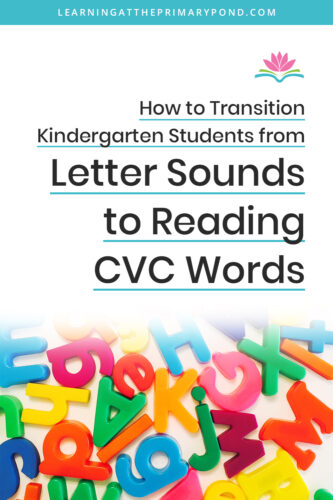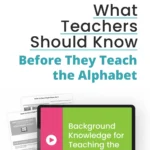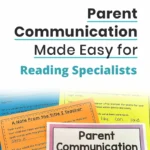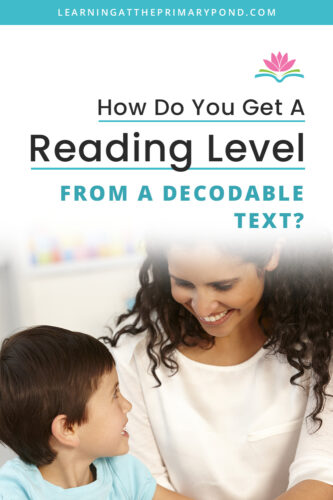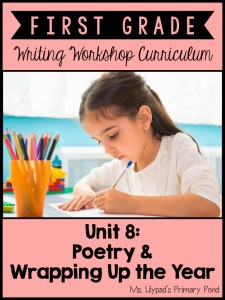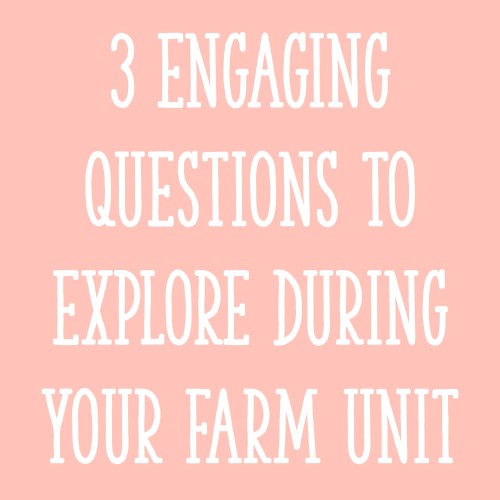Once Kindergarten students know their letters and letter sounds, so many doors open up for them! But transitioning from letters to actually reading can still feel like a giant leap! So how can you build on their momentum and confidence with letter sounds to have them actually read and write words, starting with CVC words?
What I’ve found is that balance is important – balance between teacher modeling and independent practice. At first, students will likely need a lot of modeling/support, but they also need opportunities to try out these skills on their own!
In this post, I have a video (and transcript, if you prefer to read) that will guide you in how to build students’ confidence and academic toolkit so they can successfully read and write CVC words.
(And by the way, letter sounds and CVC words are just two pieces of the phonics puzzle. if you’d like to see how I lay out the entire year in phonics skills for Kindergarten students, check out this blog post: A Yearlong Guide to Teaching Phonics in Kindergarten.)
Let’s dive in!
Transcript here:
“Hey, I’m Alison from Learning At The Primary Pond, I’m a literacy specialist, and I’m so excited for the topic of today’s video. In this video we are going to talk about helping our students make that important transition from knowing their letter sounds to actually being able to blend and read CVC words. Now, if you haven’t subscribed to my channel (https://www.youtube.com/@learningattheprimarypond) yet, I would love for you to do that now, and then also hit the little bell so that you’re notified every time I post a brand new video about teaching literacy in K2.
So let’s talk blending letter sounds, that whole transition. You know if you’ve worked with students before who are learning their letters, and everything kind of clicks, and they begin to read words, that’s just such an exciting time for them. But once they know their letter sounds, which is a huge milestone and something to be celebrated in itself, how do you build on that? And then move from there to getting students to actually reading CVC words? Which would be a logical next step. By the way CVC words, if you’re not familiar with that term, just means words that are made up of a consonant, vowel, and consonant. For example, the word ‘hat’ is an example of a CVC word, the ‘h’ and the ’t’ are the consonants, its a little vowel sandwich, in the middle is the ‘a.’ So that’s what a CVC word means, and those are typically the first types of words that kids are learning to read.
I have a question for you – have you ever hit a roadblock with students who are at this important transition phase? Maybe they do know their letter sounds, or most of them, but they are having trouble actually taking that knowledge and using it to read. If you’ve ever experienced this, just type ‘yes’ in the comments right now so that other teachers know that they are not alone in this. It can be very tricky to move kids from letter sounds to actually reading.
Before we dive into strategies to help them, and I’ve got a lot of good strategies for you, I want us to take a second and really think about all that’s required to have students read a CVC word. I’m going to write one on my little board here, and we’ll talk about what kids need to be able to do to read this word. So this word is ‘jet,’ and this is an example of a CVC word – consonant vowel, consonant, we’ve got a short vowel. Now, for us it’s just instant, it’s probably a sight word for us, there’s no decoding going on. But for a little one to read this: first, they have to recognize the alphabet letters to know that this is a ‘j,’ and an ‘e,’ and a ’t.’ They have to remember to decode the sounds left to right, so that’s one piece of it too.
They need to recall the sounds relatively quickly because if a child is sounding out, ‘j,’ and they’re thinking for a while, ‘e-e.’ If it’s slow like that, then it’s less likely that they’re going to be able to come up with the word ‘jet.’
Next, once they have remembered, they’ve accessed those letter sounds in their memory, then they have to blend them together to read the word. So we talked about alphabet recognition, left to right, accessing sounds quickly enough, and then blending. Even though this is easy for us to read, as you can see, there’s a ton of different things that go into a child being able to read this word. So I think it’s important for us to keep that in mind.
Now let’s go ahead and dive into our different strategies for getting kids to make that transition. First and foremost, I think we have to address phonological awareness or really phonemic awareness. Phonemic awareness is the awareness of individual sounds in words, so when it comes to getting kids to read CVC words, the most relevant phonemic awareness skill would be blending sounds. So if you say, ‘t-o-p,’ and the kids can come up with ‘top,’ then it’s going to be easier for them to actually read the word ‘top.’ Because when we’re doing it like this, they’re not worried about any letters, it’s just the sounds. When we take our sound knowledge, and we put that with letters, then the kids are going to be more likely to be successful. So kids should really have a good ability, or at least somewhat of an ability to blend just the sounds, no letters involved, phonemic awareness, before we start throwing a ton of CVC words at them.
It’s not to say we have to wait forever to introduce CVC words, but we want to have them have some practice with blending, because if they can’t do it with just the sounds, then they’re not going to be able to do it when we up the ante and include letters. With phonemic awareness, we can use different visual aids and movements to help practice these skills. Now again, blending is going to be what’s going to get kids to be able to read CVC words, but also segmenting is important because that will allow kids to break up words in order to write CVC words. So I’m going to show you some visuals that you might use when you’re working on blending and segmenting.
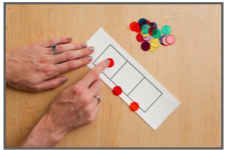
First, these are Elkonin boxes or sound boxes (see above picture). I wanted to start with this, because these are familiar to many teachers, and typically you would use these to work on segmenting. Which again, blending is a little bit more helpful for reading CVC words, but I still just wanted to start with this. So for example, if you say the word ‘hat,’ the kids are going to repeat the word ‘hat,’ and then they segment ‘h-a-t.’
However, because we said blending is so important for reading CVC words, you could also just literally have something like this displayed for the kids, and you’re doing the segmenting and they blend. So for example, you could model for them ’s-u-n,’ and you’re showing them how you do that, and then they say ‘sun.’ So really these can be used for blending or segmenting, and these are Elkonin boxes or sound boxes.
Next is a tool that may be a little bit less familiar to you. I developed it just because I found that it was a really great way for the kids to practice both blending and segmenting. So this strange-looking little card has three dots and then an arrow. Now, you can just model this too, but if you’re in a small group setting, or even whole group, you can give the kids each their own card.
If you’re practicing blending, for example if you’re going to blend the word ‘sun,’ you would say, ‘s-u-n.’ Then you want the kids to repeat those sounds, so they would also say and touch, ‘s-u-n.’ Then they would slide their finger over the arrow and say, ‘sun.’ So they repeat the sounds that you set and tapped, and then they would say the entire word while sliding their finger along the arrow at the bottom. If they were segmenting we would just reverse it, you would say the whole word, they would say the whole word, and then they would tap for the sounds. I don’t know if I said this, but blending is putting sounds together, and segmenting is taking them apart.
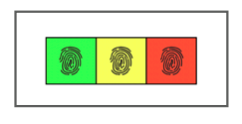
Next is another version of sound boxes. I want to hold this so it’s left to right for you. So the first sound here, you can see these are little fingerprints that just remind the kids to tap. You could even put an arrow under this if you wanted, but it goes from green, to yellow, to red to remind the kids to go from left to right. So it would basically work the same as these Elkonin or sound boxes, but they can tap sounds here. And if they’re tapping, again, that is segmenting, but if you’re telling them the sounds, then they have to say the whole word, that is blending. And then last but not least, I want to show you some possible movements that you can use when you’re working on blending sounds. Again, you can use this with segmenting too, but we’re talking about reading words, so blending is what’s most relevant here.
Different ways to do this, whatever your preference is, but I’m going to show you some options. So let’s say that you want the kids to blend the word ‘fun,’ and you’re going to only tell them the sounds, they say the whole word. So you can watch what I do with my hand, I’m moving from left to right, you say, ‘f-u-n.’ The kids then take their own hands and they go, ‘f-u-n. Fun.’ So the blending is sliding, putting the sounds together, you can also do this with tapping. Typically some fine motor skills are necessary here, but if your kids are able to do this, they go from left to right on their non-writing hand, so that if they’re eventually segmenting words in their writing they can write with their dominant hand.
So if you were going to do the word ‘fog,’ you would say ‘f-o-g.’ And then you’d slide, or rather the kids would slide, and say, ‘fog.’ So again, you want them to repeat the sounds, ‘f-o-g’ that you just said, and then they say the whole word also ‘fog.’ You can do something similar on your arm, ‘s-u-n, sun.’ Again, if you give them the sounds that’s blending, you want them to repeat the sounds and then say the whole word.
Those are just some options, so that was a big tip, but that’s tip number one and two. Work on phonemic awareness, but then also use different tools like these that I’ve shown you, use different movements. Sometimes one of these strategies will click really well with a child, but for another child something else might click with them. So you have lots of tools available to you, see what works for your students.
So far, all of that we just talked about was really about working with sounds, but of course we also need to give the kids words to work with. My next tip is when you’re teaching kids to blend, start at the beginning, doesn’t have to be always like this, but at the beginning we want to use words that have continuous sounds. The continuous sounds are sounds that can be held, so for example, the sound ‘mmmmmmmmm.’ You can keep saying it, instead of the sound, ’t.’ With ’t,’ you produce the sound, that’s a stop sound, ’t,’ you produce it and it’s over. So the continuous sounds are all the short vowels you’re going to hear in this list, but A, E, F, I, L, M, N, O, R, S, U, V, and Z. Those are the continuous sounds, you can produce them without stopping. Everything else is a stop sound.
What this would look like if you have a CVC word that has all continuous sounds like the word ‘man,’ it’s a little bit easier for the kids to read, because they can hold onto the sounds, ‘mmmmmaaaaannnnnn.’ If they were going to read the word ‘tap’ or ‘top’ that has the ’t’ and the ‘p’ and both are stop sounds, they would have to read it like ’t-o-p.’ So you can kind of hear how it’s less smooth than ‘man,’ they got to hold onto these sounds, and it’s easier because they’re continuous sounds. Now what’s most important is the first sound, because if we’re reading CVC words the middle sound is always going to be a vowel, so that’s automatically a continuous sound.
We’ll just say it’s most important that the first sound is a continuous sound. A word like ‘map,’ for example, is also pretty easy to read, because the kids can hold onto the first two sounds, which are continuous, ‘mmmmmaaaaap.’ It’s not as important that the last sound is continuous, but you definitely want to start with CVC words that do begin at least with a continuous sound.
Let’s backtrack a little bit. Before you even get into these CVC words, you might actually want to start with vowel consonant words. Vowel consonant words are two sound words, for example the word ‘up.’ When we have the word ‘up,’ there’s just less for them to deal with. We’re still starting with a continuous sound, because it’s going to be a short vowel, which all the vowels are continuous – ‘uuuup, up.’ It’s just less, fewer sounds for them to blend. So before you dive right into CVC words, you might want to work on some vowel consonant words first. And words like those are ‘at,’ ‘in,’ ‘if,’ ‘on,’ ‘up,’ ‘am.’ Although in some dialects the ‘a’ is a little bit whiny, so that one can be a little bit tricky. But those are all examples of vowel consonant words, and those are a really great place to start when it comes to blending.
Actually, I have two more tips. I was going to say my last tip, but we’ve got two more really good tips. So second to last tip is going to be to use something called successive blending. It has other names, but basically it just means that you’re having the kids blend two parts at once. So if we have the word ‘fan,’ instead of having the kids say, “f-a-n. Fan.’ what we’re going to do is we’re going to have them just hold onto the first two sounds, and then add the third one. So first they’re going to focus on blending the ‘f’ and the ‘a.’ It’s going to sound like this, fffffaaaaa, ffffffaaaaaan, fan.’ Let’s do another example with the word ‘sun.’ So instead of saying, ‘s-u-n. Sun.’ We’re going to have the kids just focus on blending two parts at a time, ‘sssssssuuuuuuu, ssssssuuuuuun, sun.’
It’s typically easier for kids to hold on to just two parts, as opposed to saying each of the three sounds individually, and then saying the whole word. Now, this works for some kids, for others it’s perfectly fine to have them say, ‘s-u-n. Sun.’ They may eventually get to that point, but again, this is just an option that’s great to try out if you notice that your students are struggling. And honestly, I would teach the success of blending upfront to all my students, and then if they eventually get to a point where they’re able to just say each sound and blend, great, but this is something that I would teach upfront.
My last tip, it’s last but not least because this is really important, is to have the kids practice in context. I was showing you individual words, very important, that’s where we start. But we eventually want them to work up to the point where they are able to read sentences with CVC words, and eventually little passages. So this is an example, I’m not sure how well you can see it, but very simple sentences. It says, ‘I see my cat.’ ‘Cat’ is obviously the CVC word to focus on. Then the next sentence is, ‘I like my cat.’ So the words ‘see’ and ‘like’ are high frequency words, but then we get into some more CVC words sprinkled in. ‘I tap my cat, I pat my cat, I fan my cat, My cat can nap.’ As you can hopefully see here from listening to me read this, you’ll see that there aren’t tons, and tons, and tons of CVC words in this text. That is intentional. Kids who are just kind of beginning to work on CVC words, or having a little bit of success, we don’t need to give them a decodable text that’s super long that has tons and tons of CVC words.
We need to limit it, because they’re blending, and they’re figuring out, they’re decoding the words. It’s going to be a little bit slower at first. That is normal, that’s okay. I’ll make sure to include a link ((https://www.teacherspayteachers.com/Product/Decodable-Readers-Beginning-CVC-Words-Kindergarten-Set-1-7060123) with this video so you can get the decodable text. I have them very specifically for beginning blenders, kids beginning to work with CVC words, where there’s not too many CVC words. And so this decodable text comes from that pack, and actually, there are book formats too. The books are really intentionally limited so that kids don’t have to decode tons and tons of CVC words, yet they’re also getting that in context practice.
For this all to be meaningful, kids really need to be reading, that’s the whole point. So when they can read sentences with CVC words, then it’s time to also bring in some little decodable texts to help them put it all together and actually read, and that is such a good feeling for them when they can finally do that. All right, I hope that all these ideas were helpful to you. If you want some resources like these beginning CVC word decodable packs, I will include that link (https://www.teacherspayteachers.com/Product/Decodable-Readers-Beginning-CVC-Words-Kindergarten-Set-1-7060123) along with this video as I mentioned. Thanks so much for watching, again, I hope this was helpful. Don’t forget to hit the like button, subscribe (https://www.youtube.com/@learningattheprimarypond), and I will see you in the next video.”
Conclusion
I hope these ideas help you and your Kindergarten students make the transition from letter sounds to reading CVC words!
For a completely FREE resource that will give your Kindergarten students practice with blending CVC words, check out my free Blending Sheets here.
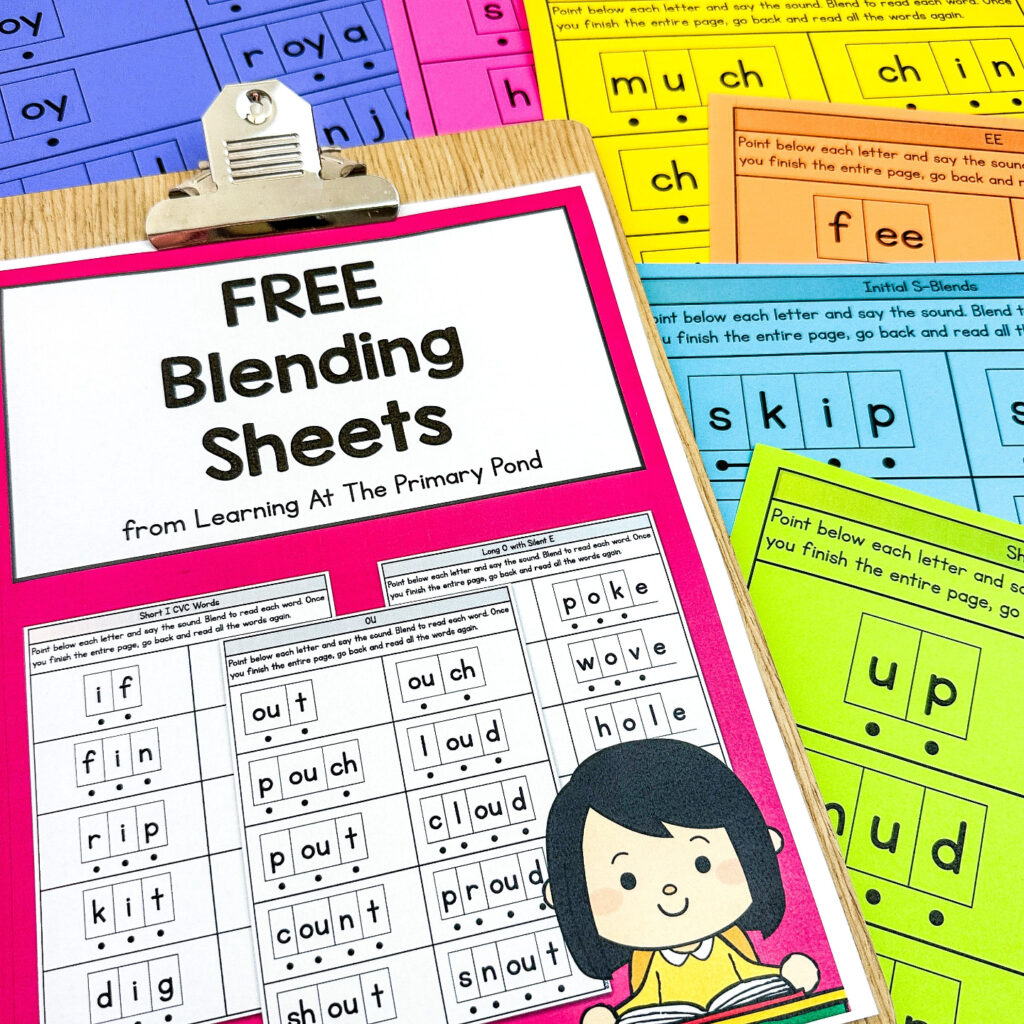
If you need texts to support those beginning readers moving into CVC words, take a look at my Decodable Readers for Beginning CVC Words. They’re specifically designed to help students make this transition; the texts were written so they don’t overwhelm kids with too many CVC words!
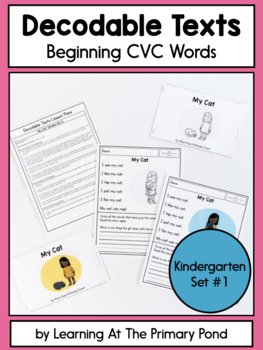
Each decodable text comes in a book, passage, and digital format so you have tons of flexibility in how to present it to students! You’ll also get a lesson plan to accompany each text. The skills covered in this set include:
- Short “a” VC and CVC words
- Short “e” CVC words
- Short “i” VC and CVC words
- Short “o” VC and CVC words
- Short “u” VC and CVC words
- Mixed CVC words
Let me know in the comments if you have any other ideas to share about this big transition from letter sounds to CVC words! Happy teaching!
